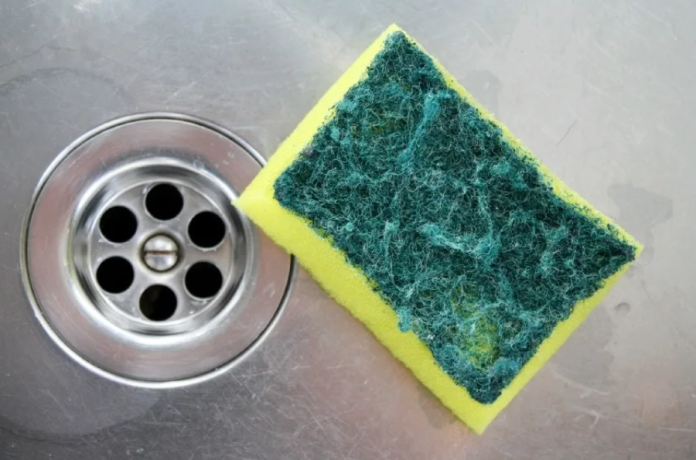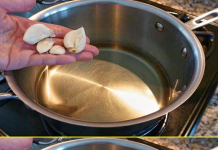You probably think the toilet seat is the dirtiest thing you come into contact with every day – but that’s far from the case!
The everyday items lurking in your kitchen, car and other areas of your home can contain thousands of times more germs than the humble latrine.
While neat freaks have weaker immune systems, poorer gut health and a higher risk of allergies, a home flooded with certain germs can be just as worrisome.
More than 65 percent of all colds, 50 percent of all cases of diarrhea and up to 80 percent of foodborne illnesses are transmitted through the home – with common household items generally considered triggers.
To strike a balance and protect yourself from illness, make these 17 germ-bearing items part of your cleaning routine:
- tea towels and sponges.
The things you use to clean your dishes and pans could make them even dirtier!
In one study, scientists found that on an average dishtowel, there are one million bacteria per square centimeter and on a kitchen sponge, as many as 10 million per square centimeter… making them 200,000 times dirtier than a toilet seat!
Another study of hundreds of U.S. households found that 7% of kitchen towels were contaminated with MRSA, an antibiotic-resistant superdrug. Coliform bacteria (present in feces) were found in 89% of cases, and E. coli in 25%.
To avoid harboring bacteria, wash your sponges, cloths and towels every two days at high temperatures. You can also heat sponges in the microwave for two minutes to kill germs. Let cloths dry between uses, as germs cannot survive more than a few hours on dry fabrics.
- Other cleaning materials

Sponges and rags aren’t the only dirty cleaning items. In fact, anything you use to pick up dirt can contain germs and provide a breeding ground for them.
Research has shown that 50% of vacuum cleaner brushes contain fecal bacteria and 13% contain E. coli.
These brushes, as well as mops, brooms, dusters and brushes, should be washed or replaced regularly.
Similarly, dishwashers and washing machines can be infested with germs, so a thorough monthly cleaning is essential.
3) Bath towels
Dead skin cells and moisture provide a breeding ground for bacteria, which is why towels are high-risk items.
And if you share towels, you risk infecting other family members: towels can transmit everything from colds and flu to serious infections, including athlete’s foot.
To avoid this, wash and replace all your towels at least every three days and use vinegar instead of fabric softener to eliminate odors and improve absorption.
4- Cutting Boards

The average cutting board contains 200% more fecal bacteria than the average toilet seat, which underscores the importance of practicing hygienic food preparation techniques.
Keep separate boards for meats and vegetables and wash them thoroughly with soap and hot water between uses.
Should I choose wooden or plastic boards? Both can be sanitary, as long as they are properly cleaned and stored according to the manufacturer’s instructions.
Old, scarred plastic boards are a haven for bacteria, while hardwood boards, such as maple, are more resistant to grooves and nicks where bacteria can hide.
Thoroughly cleaning the inside of the refrigerator, microwave, cabinets and other food contact surfaces is also important to eliminate bad bacteria.
- The sink
Both food particles and sponges contribute to the enormous amount of bacteria found in the kitchen sink, in every inch from the drain to the faucet.
In fact, there may be more than 500,000 bacteria in the kitchen sink, about 1,000 times more than in the toilet.
Experts recommend scrubbing the sink and faucet once a day with a mild bleach and water solution. For those who prefer not to use chemicals, a mixture of tea tree oil, dishwashing liquid, water and baking soda will whiten and sanitize.
- Welcome mat
While a welcome mat (or two!) can be vital in the fight against household allergens, it needs to be washed regularly or sprayed with a natural disinfectant to do its job and eliminate the large amounts of bacteria that each mat harbors.
One study even found that nearly 96% of shoe soles have traces of coliform, which is fecal bacteria!
When you vigorously wipe your feet on the welcome mat, that’s where a lot of them stay. Worse, if you don’t brush your shoes, you’re dragging these germs inside.
Remember not to put shopping bags or other items on the mat when looking for your keys.
- Toothbrushes

Bacteria, fungi and viruses such as staphylococcus and herpes simplex can survive for months on a toothbrush. Scientists have discovered that more than 100 million bacteria live on a single toothbrush.
By multiplying on the wet bristles, these germs can cause oral health problems.
Let your toothbrush dry between brushings (if necessary, use a different brush in the morning and at night); clean it regularly with castile soap and a few drops of essential oil; and replace it every three months, or more often if you get sick.
Finally, keep it away from the toilet: studies show that bacteria are sprayed up to 25 cm above the rim when you flush the toilet with the seat up!
- Makeup brushes
It’s a fact that 72% of women never wash their makeup brushes or sponges, leading to a buildup of dirt and bacteria that causes facial breakouts.
And many of us keep them in the bathroom, which is not a good idea for the same reason we shouldn’t keep our toothbrushes there.
To keep skin clean and prevent other diseases, it’s imperative to wash makeup brushes and sponges once a week. Here’s our guide to the best natural ways to wash makeup brushes.
Baking soda is a good brush cleaner – learn how to use it here.
- Purse
Another everyday item that’s dirtier than a toilet seat: women’s handbags, especially leather ones!
About one third of the bags tested contained fecal bacteria, mostly on the bottom, but also on the handle and on some objects inside, such as cosmetic jars, business cards and coins.
To keep bags clean, clean or wash them regularly and avoid placing them on the bathroom floor or on the welcome mat.
10- Coffee makers

According to a swab test on office coffee makers, more than 4 million colonies of harmful bacteria and molds – such as E. coli, staphylococcus and streptococcus – were found in the water reservoirs, capsule compartment, spout and tray of more than half of those tested.
In another study by NSF International-the public health and safety organization-the coffee maker reservoir had more germs than bathroom sinks and dog chew toys.
Here are other reasons why you should stop using your single-serve coffee maker.
- Light Switches
A bathroom light switch can contain as much bacteria as a wastebasket, according to a study from Simmons College in Boston.
Does this sound bad to you? At least those germs are yours and not likely to make you sick. Hotel rooms analyzed in a University of Houston study found that light switches are one of the most germ-contaminated items in public places.
Cleaning them once a week, especially in the bathroom and kitchen, should help keep germs at bay.










